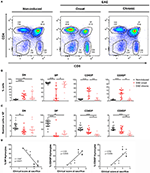

In the past few years, growing clinical, immunological and histopathological evidence suggests that MOG-EM can now be considered as a clearly distinct disease entity from both multiple sclerosis (MS) and aquaporin-4-positive neuromyelitis optica spectrum disorder (NMOSD). After years of conflicting research on the role of MOG-IgG antibodies in neuroinflammatory diseases, the methodological improvements using more reliable cell-based assays presenting human MOG protein in a biosimilar conformation have identified typical clinical presentations associated with anti-MOG-IgG antibodies, now called MOG-IgG-associated encephalomyelitis (MOG-EM). Myelin oligodendrocyte glycoprotein (MOG) is an encephalitogenic protein on CNS oligodendrocytes that can initiate demyelinating autoimmune responses in experimental models of inflammatory demyelinating diseases. We identify common pathological findings in patients with LETM as first clinical presentation of MOG-EM which distinguishes it from other forms of LETM and should lead to testing for MOG-IgG in these cases.

Patients with LETM as first clinical presentation of MOG-EM display similar characteristics, namely a lack of gadolinium-enhancement in spinal cord MRI, marked pleocytosis, negative oligoclonal bands, a previous history of infections/vaccinations and response to antibody-depleting treatments for acute attacks and long-term treatment. MethodsĪfter excluding patients with a known diagnosis of MS, we identified 153 patients with myelitis of which 7 fulfilled the inclusion criteria and were investigated for MRI, CSF and clinical parameters. To evaluate common clinical, MRI and CSF findings, as well as therapy responses in patients with longitudinal extensive transverse myelitis (LETM) as initial clinical presentation of MOG-EM. MOG-EM is associated with a broader clinical phenotype including optic neuritis, myelitis, brainstem lesions and acute disseminated encephalomyelitis with a substantial clinical and radiological overlap to other demyelinating CNS disorders. Based on clinical, immunological and histopathological evidence, MOG-IgG-associated encephalomyelitis (MOG-EM) has emerged as a distinct disease entity different from multiple sclerosis (MS) and aquaporin-4-antibody-positive neuromyelitis optica spectrum disorder (NMOSD).


 0 kommentar(er)
0 kommentar(er)
